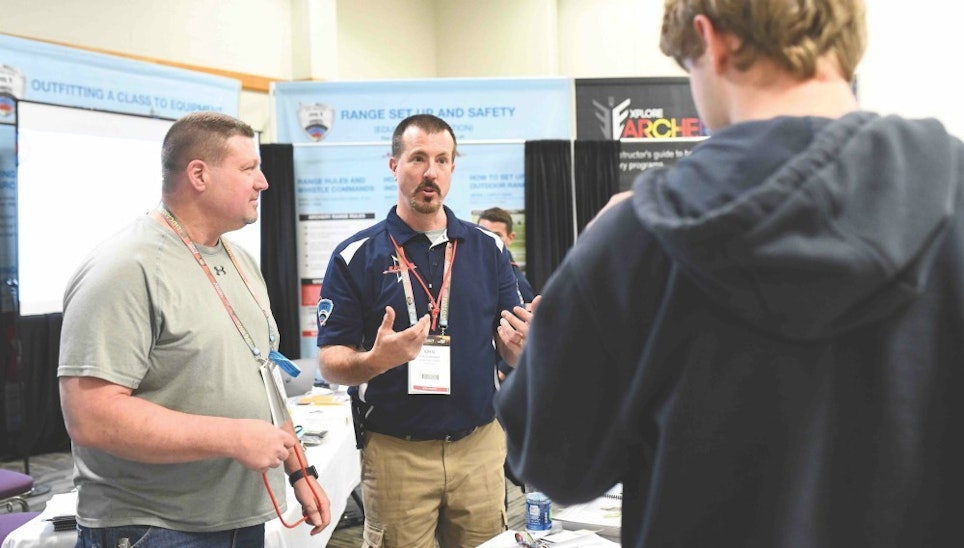I vividly remember leaving my first archery trade show — the 2002 AMO Show in Nashville, Tennessee — with a newfound skip in my step. My parents had recently purchased our family’s archery pro shop, and I couldn’t believe no one had previously told me about this seemingly mystical world where dealers, manufacturers, press and TV personalities converge to conduct business. My young eyes gawked as I bumped shoulders with industry bigs.
Had the ordering been on my shoulders that first year, the family pro shop would’ve been in big trouble because my senses were numbed by all of the popular blood in the room. Thankfully, my parents and eldest brother did the purchasing while I obtained autographs and probably annoyed a lot of people. I learned absolutely nothing, but I was also only 12 years old and just getting my first taste of the industry.
After I’d matured and gained a couple more years of retail and trade show experience, my parents integrated me into the obligatory purchasing duties at the trade shows. I started providing insights based on sales trends I’d identified throughout the year, not to mention helping fill out orders and attending morning seminars. Suddenly, I understood the great responsibilities that attending trade shows entails. Sure, it’s OK to soak up the electrifying atmosphere, but don’t forget the intended purpose of attending trade shows, which is to do business.
Perhaps more important than attending the shows is making the best use of your time, and applying what you learn when you return to your shop. Here are a few ways to make the most of the post-show months.
Be Open-Minded
There are three types of dealers. First, there are the new ones who get as much out of the trade shows as I did my first. Then, there are folks who’ve been in archery retail so long that they fall into the growly, I-know-everything category. Finally, there are those who are focused on improving on both personal and business levels. The latter benefit most from trade shows because they’re actively seeking input and are willing to learn.
Beyond that, they’re aggressive with integrating what they learn into their businesses. If you harbor this mindset throughout the show season, you’ll retain more information that can prove beneficial when you sit down after the shows to regroup and re-evaluate your business.
Network
One of the most beneficial things a retailer can do at trade shows is create a network of friends. A good network consists of other retailers and manufacturers. When you make good friends, you have the power to influence and be influenced. You’ll also have good resources at your disposal should you find yourself in a difficult situation or just needing someone to talk to.
The archery industry is a close-knit bunch. Sure, we all have our differences, but that’s the beauty of it — we all bring something different to the table. Don’t fall into the I-know-everything trap. Be willing to cultivate solid archery industry relationships. Networking is an underrated tactic that can have a powerful impact on your business. Best of all, it’s free and available all year.
Regroup
Trade shows are crammed into tight windows that blow by incredibly fast. If you don’t pay attention, you could easily miss out on some benefits. That’s why it’s vital to stay focused and organized, making the most of your time.
Take the ATA Show, for example. In just three days, aggressive dealers have large to-do lists. There are the obvious ordering duties, as well as screening new products to find hot, new picks. But, opportunities to learn also abound. What you learn though, can get lost in the shuffle, so it’s important to take notes and then sit down to study them after the show concludes to determine what makes sense in terms of potential changes to your business.
“It’s important to review things that you learned at a show once you get home and the dust settles,” Kurt Smith of the ATA said. “Dealers who pay attention, can obtain good, positive information. If it wasn’t information from one of the seminars, maybe it was something you learned while talking with an exhibitor or even another dealer. The important part is writing things down so that you can revisit them after the show.
“As you review what you’ve learned, it’s smart to weed out unimportant things and focus on even just one or two powerful ideas that could be useful for your business. Those ideas can easily be forgotten, so make sure to write down some concrete plans for implementing those ideas. Then, post them in a prominent location where you’ll see them daily. So often, retailers are like, ‘Oh! That’s a good idea!’ when they’re at the Show. But, it most often dies on the vine because they return to their shops and do what they’ve always done.” That vicious cycle can repeat itself annually if you don’t become intentional about applying new ideas.
“It’s wise to evaluate where you’re at with your business following the ATA Show,” Smith said. “Identify areas with room to improve and grow. Don’t attempt to conquer everything immediately. You can’t possibly accomplish every idea you learn about in one month or even one year. Plus, that isn’t the goal. The goal is to implement solid strategies toward bettering your business. If you do this, your business will be in far better condition 10 years down the road than it would be if you continued doing things the same way.”
Discuss
Once you’ve regrouped and settled on some viable changes and plans to accomplish them, inform your entire team. When you sit down as a team, you can conduct some highly productive brainstorming sessions following the trade shows. Taking solid information from the trade shows and discussing it as a team is likely to trigger many valuable ideas.
“For shops that have more than one staff member — a team — it’s wise to engage in discussion,” Smith said. “You can get everyone on the same page working toward common goals. Together, you can begin to make positive changes based on what you learned at the trade shows. For many shops, the post-show period is a great timeframe during which to brainstorm with your staff.”

Get Plugged In
“ATA Connect is an online forum that’s just for ATA members,” Smith said. “It’s sort of a continuation of the networking that happens on the show floor. You can get some good ideas from other people. You can post questions and get input from other retailers. ATA Connect is a great platform we provide that can keep everyone informed and connected all year long.
“ATA also publishes articles throughout the year on its website. We try to keep pumping out fresh content. We also send out e-mail newsletters to keep folks informed on what’s happening within the archery industry. I also do a podcast about once monthly. On it, I talk with different folks in the industry and get their insights. Often, these are little niche aspects. It’s just another medium we use to publicize valuable information.
“Finally, we’re starting a learning management system online. It’s a place our members can go for seminars and other educational offerings. The seminars are videoed and available on demand online. This is a continuation of the learning experience we offer at ATA so that dealers can keep accessing good resources for business-improvement purposes throughout the year. We’re just getting this started, but we believe it will be beneficial to our dealer members. We understand that every show gets busy and that many dealers only make it to one or two seminars. Or, perhaps a few employees from certain shops were unable to attend the ATA Show. This platform will keep putting positive information out there for all to utilize.”
Don’t Miss Out
Marty Stubstad of Archery Headquarters in Rochester, Minnesota, believes it’s easy to miss a popular new product or two while perusing the floor.
“I don’t rely on them as much as I should, but the media available to us can be beneficial in identifying new products after the show that we happened to miss during the show,” he said. “After the show is a great time to sit down and cycle through trade magazines and online media to see if we missed a product that other folks are raving about.”
Educate
John and Wilma Stone of The Archery Hut in Lebanon, Oregon, run their store alone, except for occasional part-time help during the busy seasons. Because they’ve been running the business successfully for more than 40 years, they choose to use the post-show months as a time to educate their customers.
“We sit down after the ATA Show to look at everything and then put together a few seminars to educate our newer customers,” John said. “We’re always open to teaching classes and things like that. Unlike newer stores that are trying to launch their businesses, we’re well established, so our focus is a bit different than younger businesses. We’ve been doing this for so long that we pretty much know what we’re going to be doing each year, although we remain attentive to new ideas.”
Last Call
To make the most out of the trade show season, you must first integrate into the industry by attending trade shows.
“The best thing new dealers can do is go to the ATA Show,” Stone said. “ATA is all about the pro shops and equipping them to succeed. Set up a schedule of vendors you have to meet. Sometimes new dealers go to a show and find it overwhelming. It’s like, ‘Oh my gosh. What should I do?’ Stay on schedule, keep close contact with your different vendors and stay focused. Those are my best suggestions to newer dealers.”
For Stubstad, the post-show months are all about evaluating programmed orders. “As merchandise begins arriving,” he said, “I evaluate how close I was to my projections. In other words, it’s a time for me to ask, ‘Was I a smart shopper?’ It’s always challenging to predict what to order. But, that’s why it pays to make this evaluation each year. Obviously, archery sales ebb and flow from year to year, but the more you put your finger on the pulse, the better you’ll become at purchasing accurate amounts of merchandise.”
Sidebar: Join a Buying Group
Marty Stubstad encourages joining a buying group like ARRO or NABA, promoting it as a wise move that comes with many benefits.
“It’s so important to belong to a buying group like ARRO,” he said. “The profit margins are greater, and with the online world, we as pro shops have to remain competitive with our pricing. Beyond that, it simplifies things at the ATA Show. The ARRO Hot Show is a stepping stone to the ATA Show. It gives dealer members a first look at new products a couple of days before the ATA Show, and you get to spend more one-on-one time with manufacturers. The Hot Show is a great place to form close relationships with your vendors.
“This makes the expansive ATA Show feel more manageable since a large amount of your business is already complete. You can walk into it prepared to attend seminars and search for cool new products without so much pressure riding on your shoulders. I recommend that all dealers consider joining a buying group like ARRO. The benefits are numerous.”







